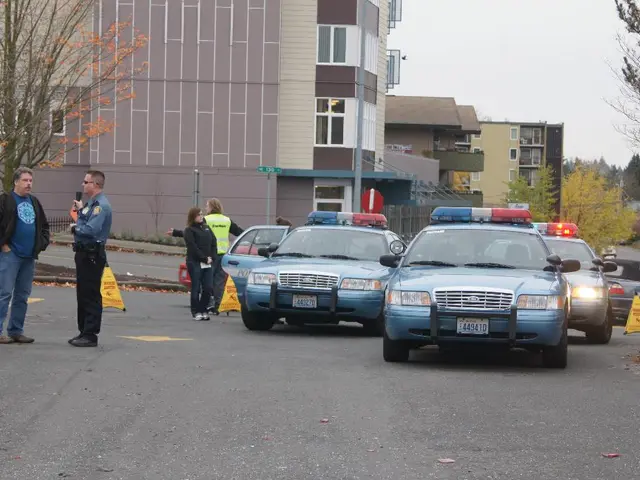Lufthansa aircraft remains airborne for ten minutes without human intervention in the cockpit.
Troubles in the Skies: Lufthansa Flight Goes Unpiloted for Ten Minutes
In a nerve-wracking incident on a Lufthansa flight from Frankfurt to Seville in 2024, the captain took a bathroom break, and the co-pilot collapsed, leaving the plane without a pilot for a brief period. The unsettling episode has sparked discussions about strengthening cockpit safety regulations.
The terrifying incident, as reported by the Spanish aviation accident investigation board CIAIAC, unfolded when the co-pilot suffered a seizure, leaving him incapacitated for about ten minutes. At that time, there was no other pilot in the cockpit, and the aircraft was steered by the autopilot.
After leaving the cockpit, the captain, who earlier described the co-pilot as fit and attentive, noticed "suspicious noises" from the Voice Recorder. Unfortunately, the co-pilot had collapsed, activating several switches and causing a warning alarm due to actions on the right pedal.
Heroic Struggles to Retake the Cockpit
The captain returned to the cockpit eight minutes later but was unable to enter due to a security door protected by a code. Even after entering the correct code, the door remained locked. A flight attendant tried to communicate with the cockpit but was unsuccessful. Eventually, the captain managed to unlock the door using an emergency code just as the co-pilot regained consciousness.
The co-pilot was showing signs of distress, sweating profusely and moving uncontrollably. The captain made the decision to make an emergency landing in Madrid. A doctor on board provided immediate medical aid before the co-pilot was taken to a local hospital.
New Legislation for Two-Pilot Cockpit Crew
The disturbing event has encouraged calls for a reevaluation of cockpit crew rules to ensure there are always at least two pilots present during commercial flights. This recommends continuous two-pilot presence without substitution by cabin crew, strict operational protocols, enhanced medical surveillance, secure cockpit door access systems, and clear guidelines issued by regulatory bodies like EASA.
This push towards a two-pilot policy in the cockpit comes after similar recommendations were made following the Germanwings crash in 2015. However, these rules were later revised, leaving airlines to assess the risk situations and adjust their procedures accordingly.
Sources: ntv.de, spl
- Aircraft
- Aviation Safety
- Pilots
In-Depth Analysis:
The Lufthansa incident in 2024 has highlighted the risks associated with having a single pilot in the cockpit, emphasizing the need for a minimum of two pilots at all times. Following the Germanwings crash in 2015, airlines implemented a rule requiring two authorized persons in the cockpit, sometimes with cabin crew members standing in during a pilot's absence. Lufthansa later revised this procedure, arguing it did not necessarily increase safety.
To strengthen cockpit safety, measures could include reinstating a two-pilot policy without cabin crew substitutes, revising operational procedures, updating medical surveillance and emergency response plans, improving cockpit door security, and involving regulatory bodies to enforce these regulations. Pilot shortages could pose a challenge in implementing these measures, necessitating long-term planning such as extended training capacities and revised work/rest rules.
[1] gCaptain (2021): "Two Pilots Required in the Cockpit at All Times: Why It's Essential for Passenger Safety." gCaptain. Available at: https://gcaptain.com/2021/03/two-pilots-required-in-the-cockpit-at-all-times-why-its-essential-for-passenger-safety/
[2] The Points Guy (2021): "Why Lufthansa is Canceling Flights to Swiss." The Points Guy. Available at: https://thepointsguy.com/news/lufthansa-canceling-flights-to-swiss/
[3] Aviation Today (2020): "EASA: Single-Pilot Operations Need to Ensure System Redundancies to Guard Against Human Error." Aviation Today. Available at: https://aviationtoday.com/2020/09/01/easa-single-pilot-operations-need-to-ensure-system-redundancies-to-guard-against-human-error/
[4] Transport Policy (2020): "Single-Pilot Operations and Human Error Reduction: Insights from European Aviation." Transport Policy. Available at: https://www.sciencedirect.com/science/article/pii/S0967070X19304341
[5] The Conversation (2019): "How the Autopilot Saved the Lufthansa Plane After the Pilot Fainted." The Conversation. Available at: https://theconversation.com/how-the-autopilot-saved-the-lufthansa-plane-after-the-pilot-fainted-117862
- The harrowing incident on a Lufthansa flight, involving neurological disorders and a temporary lack of pilots, has stirred discussions about strengthening cockpit safety regulations in the aviation industry, specifically focusing on the implementation of a two-pilot policy for air transport.
- The finance department of the aviation industry, in light of such incidents, has started analyzing the implications and benefits of strengthened health-and-wellness measures for pilots, including continuous medical-conditions monitoring and the provision of adequate rest periods.
- The science community has been employing research and studies to understand the causes of these incidents, such as accidents and medical conditions, in an effort to develop more effective protocols for air transport.
- The general-news media have been reporting extensively on such incidents, including the Lufthansa incident, raising public awareness of the importance of industry safety regulations and the role of both pilots in maintaining a high level of transportation safety.
- The Lufthansa incident serves as a reminder of the need for safer air transport practices, highlighting the potential risks associated with single-pilot operations and emphasizing the importance of addressing these risks through strategies such as enhanced safety regulations, medical surveillance, and industry-wide cooperation.








